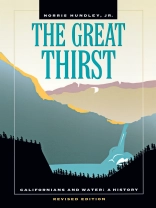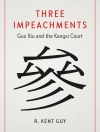The story of ‘the great thirst’ is brought up to date in this revised edition of Norris Hundley’s outstanding history, with additional photographs and incisive descriptions of the major water-policy issues facing California now: accelerating urbanization of farmland and open spaces, persisting despoliation of water supplies, and demands for equity in water allocation for an exploding population. People the world over confront these problems, and Hundley examines them with clarity and eloquence in the unruly laboratory of California.
The obsession with water has shaped California to a remarkable extent, literally as well as politically and culturally. Hundley tells how aboriginal Americans and then early Spanish and Mexican immigrants contrived to use and share the available water and how American settlers, arriving in ever-increasing numbers after the Gold Rush, transformed California into the home of the nation’s preeminent water seekers. The desire to use, profit from, manipulate, and control water drives the people and events in this fascinating narrative until, by the end of the twentieth century, a large, colorful cast of characters and communities has wheeled and dealed, built, diverted, and connived its way to an entirely different statewide waterscape.
The story of ‘the great thirst’ is brought up to date in this revised edition of Norris Hundley’s outstanding history, with additional photographs and incisive descriptions of the major water-policy issues facing California now: accelerating urbanization
Cuprins
List of Figures
List of Maps
Preface to the Revised Edition
1. The Aboriginal Waterscape: Manipulation and Near Harmony
The Waterscape
Waterways and Lifeways
Agriculture and Cultural Patterns
Symbiosis and Community
2. Hispanic Patterns: Community and Authority
‘Apportion Water Justly and Fairly’
Lessons in Survival
Misjudgments
Royal Authority and Community Rights
Community Obligations
Community Rights and Private Rights
When Rights Collide: Bien Procumunal
The Darker Side
3. The American Takeover: Laissez-Faire, Localism, and Monopoly
American Political Culture
‘First in Time, First in Right’
Hydraulicking and Environmental Destruction
The Politics of Flood Control
Riparian Rights
Monopoly and a Clash of Rights
Lux v. Haggin and the California Doctrine
The Irrigation District and the Persistence of Monopoly
Localism and the Search for Alternatives
The Rainmakers
The Progressive Impulse: From Laissez-Faire to Centralized Planning
Toward the Reclamation Act
4. Urban Imperialism: A Tale of Two Cities
Los Angeles: From Hispanic Village to American City
Legerdemain and the Pueblo Water Right
Girding for Expansion: Municipal Control
The Owens Valley Caper
An Aqueduct for the Future
The San Fernando Valley: Insider Information for Private Gain
Los Angeles’ Water Colonies
The Tragedy and Legacy of the Expert: William Muholland
San Francisco: Instant City with an Instant Water Problem
Hetch Hetchy Predicaments: The Federal Government and Boss Ruef
Hetch Hetchy Embattled
Toward a Utilitarian Triumph
The Ironies of Victory
A Comparison of Two Cities
5. Hydraulic Society Triumphant: The Great Projects
The Boulder Canyon Project
The Imperial Valley Impulse
The Colorado River Compact
New Players and New Battles
Compromises and Enactment
The Imperial Valley and the Betrayal of Reclamation Law
New Water and Accelerated Urbanization
The Central Valley Project
Progressive Era Promise and Disappointment
Toward a State Plan
American Political Culture and the Central Valley Project
From State to Federal Project
A Project at Last
The Battle over Acreage Limitation
‘Technical Compliance’: A Bipartisan Legacy
Public versus Private Power
The State Water Project
A State Plan
Fragmentation, Compromise and Confusion
New Water, Growth, and Inequities
6. Hydraulic Society on the Defensive
Arizona v. California
The Environmental Movement
The Peripheral Canal Fight: Round One
The Peripheral Canal Fight: Round Two
The Pueblo Water Right Challenged
Mono Lake and the Public Trust Doctrine
Owens Valley War: Renewed and Cooled But Not Over
The Fight for the Right to Instream Use
An Increasingly Vulnerable Southland
7. Water Policy at a Crossroads
Tradition versus Reform: The Fate of the Stanislaus River
New and Old Challenges to Dams and Levees
Dams at Risk
The Impermanence of Dams: Earthquakes, Silt, Neglect, and Flawed Planning
Los Angeles: A Vexing in Dams, Levees, Floods and Public Policy
Vulnerable Levees and the Delta
Environmental Crisis: Bay, Delta, and CALFED
Environmental Crisis: Central Valley
Environmental Crisis: Southern California
Subsidized Agriculture and Social Inequity
Water Marketing: Hope, Threat, and Challenge
The Imperial Valley, MWD, and the Market
The Imperial Valley, MWD, San Diego and the Market
The Wheeling-Rate War: MWD and San Diego
The Government Intercedes
One War Down, Another to Go
The Central Valley Project, ‘Reform, ‘ and the Market
MWD, the San Joaquin Valley, and the Market
The Quest for Security and Equity
Open Spaces and Farmland: Going, Going…
A Confusion of Laws
Chaotic Management
Calls for Reform, Fanciful and Otherwise
8. Reflections
Notes
Bibliography
Index
Despre autor
Norris Hundley, Jr. is Professor of American History at the University of California, Los Angeles. The Great Thirst, a bestseller in its first edition, was preceded by other books including California: History of a Remarkable State (with John Caughey, 1982).












